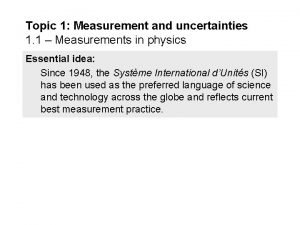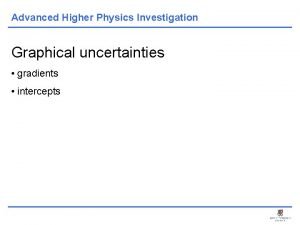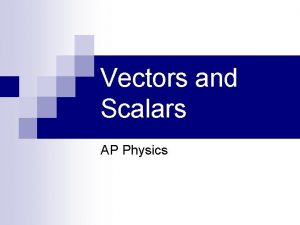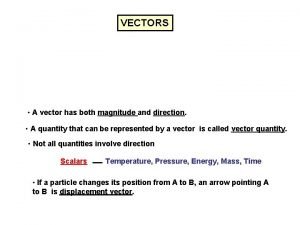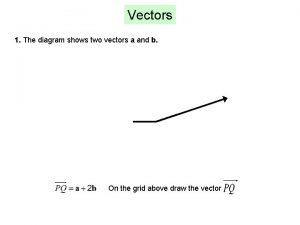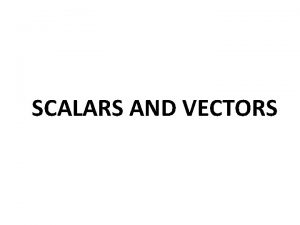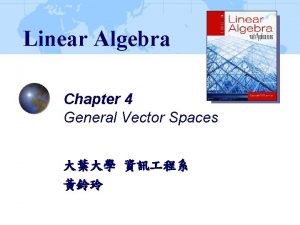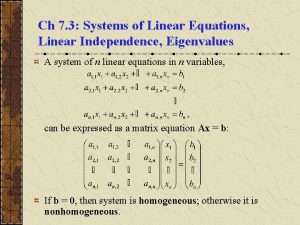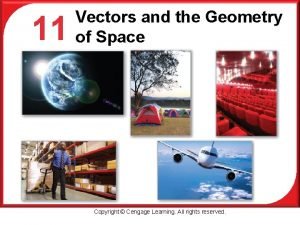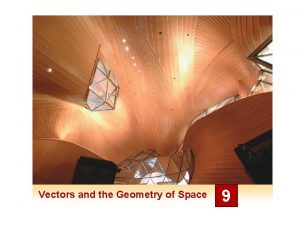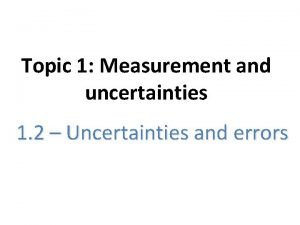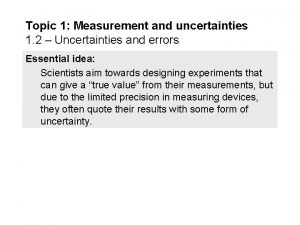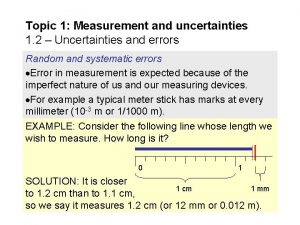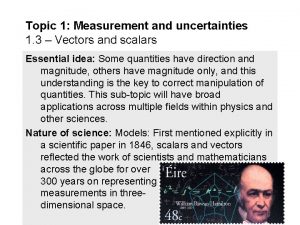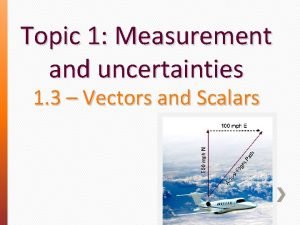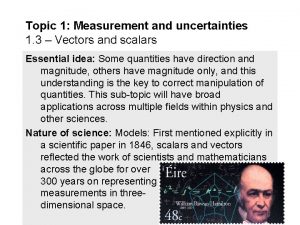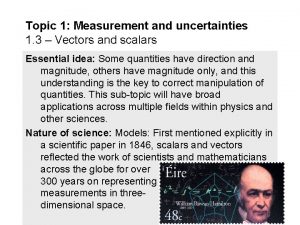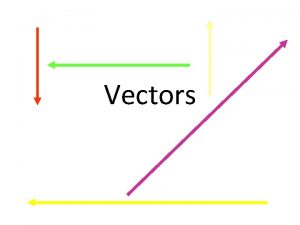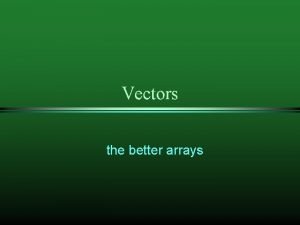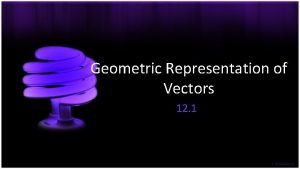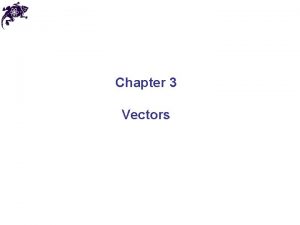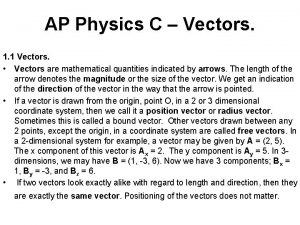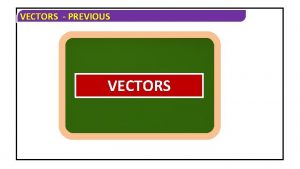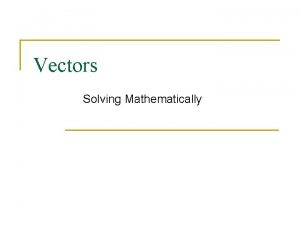Topic 1 Measurement and uncertainties 1 3 Vectors






















- Slides: 22

Topic 1: Measurement and uncertainties 1. 3 – Vectors and scalars Guidance: • Resolution of vectors will be limited to two perpendicular directions • Problems will be limited to addition and subtraction of vectors and the multiplication and division of vectors by scalars Data booklet reference: • AH = A cos AV A • AV = A sin AH

Topic 1: Measurement and uncertainties 1. 3 – Vectors and scalars Vector and scalar quantities A vector quantity is one which has a magnitude (size) and a spatial direction. A scalar quantity has only magnitude (size). EXAMPLE: A force is a push or a pull, and is measured in newtons. Explain why it is a vector. SOLUTION: Suppose Joe is pushing Bob with a force of 100 newtons to the north. Then the magnitude of the force is 100 n. The direction of the force is north. Since the force has both magnitude and direction, it is a vector.

Topic 1: Measurement and uncertainties 1. 3 – Vectors and scalars Vector and scalar quantities A vector quantity is one which has a magnitude (size) and a spatial direction. A scalar quantity has only magnitude (size). EXAMPLE: Explain why time is a scalar. SOLUTION: Suppose Joe times a foot race and the winner took 45 minutes to complete the race. The magnitude of the time is 45 minutes. But there is no direction associated with Joe’s stopwatch. The outcome is the same whether Joe’s watch is facing west or east. Time lacks any spatial direction. Thus time is a scalar.

Topic 1: Measurement and uncertainties 1. 3 – Vectors and scalars Vector and scalar quantities A vector quantity is one which has a magnitude (size) and a spatial direction. A scalar quantity has only magnitude (size). EXAMPLE: Give examples of scalars in physics. SOLUTION: Speed, distance, time, and mass are scalars. We will learn about them all later. EXAMPLE: Give examples of vectors in physics. SOLUTION: Velocity, displacement, force, weight and acceleration are all vectors. We will learn about them all later.

Topic 1: Measurement and uncertainties 1. 3 – Vectors and scalars Speed + Speed Velocity Direction direction magnitude Vector and scalar quantities Speed and velocity are examples of vectors you are already familiar with. Speed is what your speedometer reads (say 35 km h-1) while you are in your car. It does not care what direction you are going. Speed is a scalar. Velocity is a speed in a particular direction (say 35 km h-1 to the north). Velocity is a vector. VECTOR SCALAR

Topic 1: Measurement and uncertainties 1. 3 – Vectors and scalars Vector and scalar quantities Suppose the following movement of a ball takes place in 5 seconds. x/m Note that it traveled to the right for a total of 15 meters in 5 seconds. We say that the ball’s velocity is +3 m/s (+15 m / 5 s). The (+) signifies it moved in the positive x-direction. Now consider the following motion that takes 4 seconds. x/m Note that it traveled to the left for a total of 20 meters. In 4 seconds. We say that the ball’s velocity is - 5 m/s (– 20 m / 4 s). The (–) signifies it moved in the negative x-direction.

Topic 1: Measurement and uncertainties 1. 3 – Vectors and scalars Vector and scalar quantities It should be apparent that we can represent a vector as an arrow of scale length. v = +3 m s-1 v = -4 m s-1 x/m There is no “requirement” that a vector must lie on either the x- or the y-axis. Indeed, a vector can point in any direction. -1 Note that when the vector is at an s m 3 angle, the sign is rendered v= meaningless. v= 4 m s -1

Topic 1: Measurement and uncertainties 1. 3 – Vectors and scalars Vector and scalar quantities PRACTICE: SOLUTION: Weight is a vector. Thus A is the answer by process of elimination.

Topic 1: Measurement and uncertainties 1. 3 – Vectors and scalars Combination and resolution of vectors Consider two vectors drawn to scale: vector A and vector B. In print, vectors are designated in bold non-italicized print: A, B. When taking notes, place an arrow over your vector quantities, like this: B A Each vector has a tail, and a tip (the arrow end). tip tail B A tail tip

Topic 1: Measurement and uncertainties 1. 3 – Vectors and scalars Combination and resolution of vectors Suppose we want to find the sum of the two vectors A + B. We take the second-named vector B, and translate it towards the first-named vector A, so that B’s TAIL connects to A’s TIP. The result of the sum, which we are calling the vector S (for sum), is gotten by drawing an arrow from the START of A to the FINISH of B. tip tail B A START tail FINISH = A+ B S tip

Topic 1: Measurement and uncertainties 1. 3 – Vectors and scalars Combination and resolution of vectors As a more entertaining example of the same technique, let us embark on a treasure hunt. Arrgh, matey. First, pace off the first vector A. And ye'll be findin' a treasure, aye! Then, pace off the second vector B.

Topic 1: Measurement and uncertainties 1. 3 – Vectors and scalars Combination and resolution of vectors We can think of the sum A + B = S as the directions on a pirate map. We start by pacing off the vector A, and then we end by pacing off the vector B. S represents the shortest path to the treasure. B end A S start A+ B = S

Topic 1: Measurement and uncertainties 1. 3 – Vectors and scalars Combination and resolution of vectors PRACTICE: SOLUTION: Resultant is another word for sum. Draw the 7 N vector, then from its tip, draw a circle of radius 5 N: The shortest possible vector Various choices for the 5 N vector are is 2 N. illustrated, together with their vector sum:

Topic 1: Measurement and uncertainties 1. 3 – Vectors and scalars Combination and resolution of vectors c SOLUTION: Sketch the sum. y x = x + y

Topic 1: Measurement and uncertainties 1. 3 – Vectors and scalars Combination and resolution of vectors Just as in algebra we learn that to subtract is the same as to add the opposite (5 – 8 = 5 + -8), we do the same with vectors. Thus A - B is the same as A + - B. All we have to do is know that the opposite of a vector is simply that same vector with its direction reversed. -B the vector B B A + -B -B A the opposite of the vector B Thus, A - B = A + - B

Topic 1: Measurement and uncertainties 1. 3 – Vectors and scalars Combination and resolution of vectors SOLUTION: Sketch in the difference. Z=X -Y x -y

Topic 1: Measurement and uncertainties 1. 3 – Vectors and scalars Combination and resolution of vectors To multiply a vector by a scalar, increase its length in proportion to the scalar multiplier. Thus if A has a length of 3 m, then 2 A has a length of 6 m. 2 A A To divide a vector by a scalar, simply multiply by the reciprocal of the scalar. Thus if A has a length of 3 m, then A / 2 has a length of (1/2)A, or 1. 5 m. A/2 A FYI In the case where the scalar has units, the units of the product will change. More later!

Topic 1: Measurement and uncertainties 1. 3 – Vectors and scalars y/m Combination and resolution of vectors Suppose we have a ball moving simultaneously in the x - and the y-direction along the diagonal as shown: FYI The green balls are just the shadow of the red ball on each axis. Watch the animation repeatedly and observe how the shadows also have velocities. x/m

Topic 1: Measurement and uncertainties 1. 3 – Vectors and scalars 9 m y/m Combination and resolution of vectors We can measure each side directly on our scale: Note that if we move the 9 m side to the right we complete a right triangle. Clearly, vectors at an angle can be broken down into the pieces represented by their shadows. 25 m 23. 3 m x/m

Topic 1: Measurement and uncertainties 1. 3 – Vectors and scalars vertical component AV AV Combination and resolution of vectors Consider a generalized vector A as shown below. We can break the vector A down into its horizontal or x -component Ax and its vertical or y-component Ay. We can also sketch in an angle, and perhaps measure it with a protractor. In physics and most sciences we use the Greek letter (theta) to represent A an angle. From Pythagoras we AH have horizontal 2 = A 2 + A 2. A H V component

Topic 1: Measurement and uncertainties 1. 3 – Vectors and scalars opposite Combination and resolution of vectors Recall the trigonometry of a right triangle: AH opp AV A opp adj V sin = cos = tan = adj AH hyp A e s u A ten o AV = A sin θ p y h s-o-h-c-a-h-t-o-a adjacent trigonometric ratios AH = A cos θ EXAMPLE: What is sin 25° and what is cos 25°? SOLUTION: FYI sin 25° = 0. 4226 Set your calculator to “deg” using cos 25° = 0. 9063 your “mode” function.

Topic 1: Measurement and uncertainties 1. 3 – Vectors and scalars AV AV Combination and resolution of vectors EXAMPLE: A student walks 45 m on a staircase that rises at a 36° angle with respect to the horizontal (the xaxis). Find the x- and y-components of his journey. SOLUTION: A picture helps. AH = A cos m 5 4 = = 45 cos 36° = 36 m A AV = A sin = 36° = 45 sin 36° = 26 m AH FYI To resolve a vector means to break it down into its xand y-components.
 Relative uncertainty
Relative uncertainty Measurement topic
Measurement topic Random uncertainty
Random uncertainty Advanced higher physics uncertainties
Advanced higher physics uncertainties General topic example
General topic example Narrow topic examples
Narrow topic examples Maps and plans grade 11
Maps and plans grade 11 Example of multimodal text
Example of multimodal text Vector properties
Vector properties Vectors and scalars in physics
Vectors and scalars in physics What are i and j in vectors
What are i and j in vectors Magnitude formula
Magnitude formula A vector has both magnitude and
A vector has both magnitude and Trapezium vector
Trapezium vector Sin 37
Sin 37 Difference between vectors and scalars
Difference between vectors and scalars Entropy is scalar or vector
Entropy is scalar or vector Inner product matrix
Inner product matrix Linearly dependent and independent vectors
Linearly dependent and independent vectors Vectors and the geometry of space
Vectors and the geometry of space Linear dependency
Linear dependency Find the scalar and vector projections of b onto a
Find the scalar and vector projections of b onto a Lesson plan on vectors and scalars
Lesson plan on vectors and scalars

